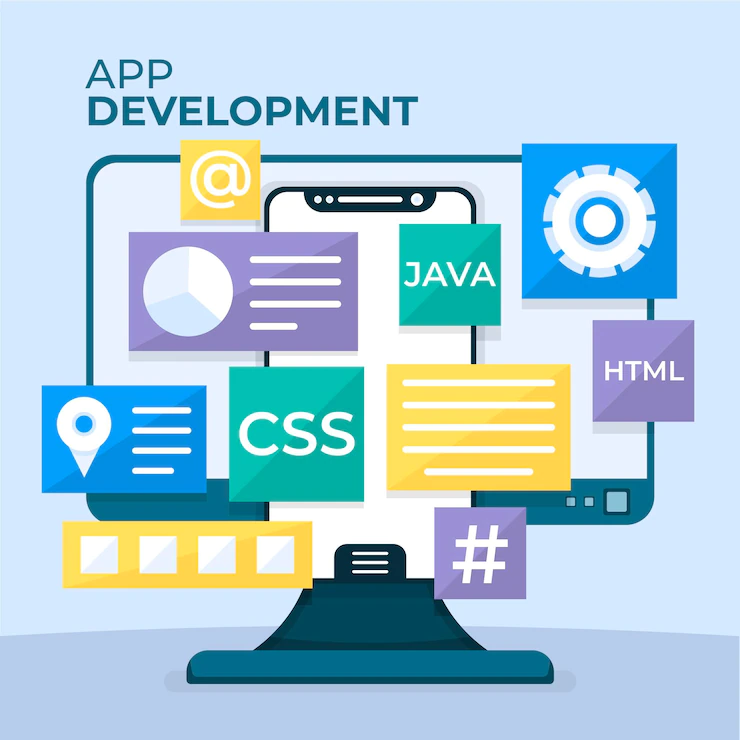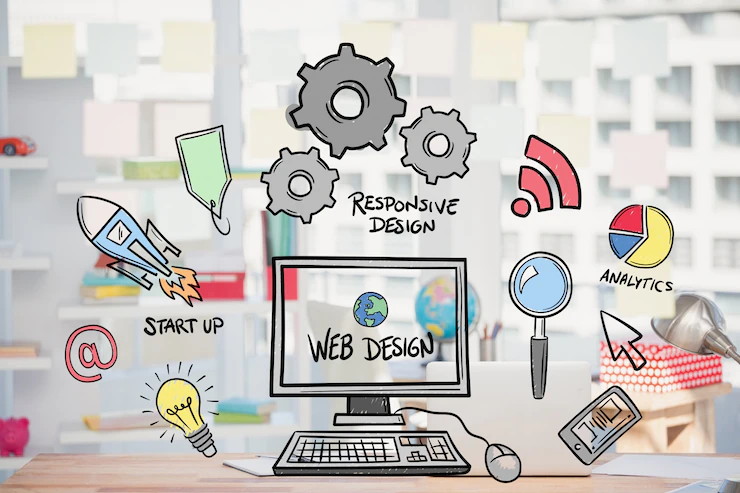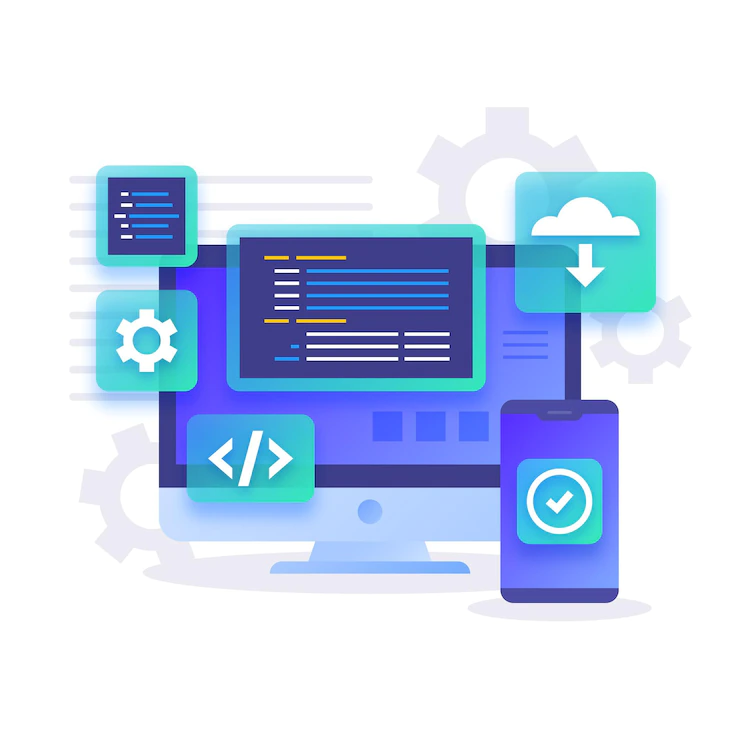Web App Development
Why do you need a web app? After all, smartphones have revolutionized our way of life. Why don’t you focus your energy and time on developing mobile apps? Well, consumers and the target market have unique preferences. Companies, businesses, consultants and freelancers must reach wide consumer markets. The target customers should access crucial business information and services using different devices. What happens if a smartphone goes off while ordering something from an online store? Do they stop shopping? Or can they log on to the web app and proceed to complete making the order?
Web app development is a fast-paced, ever-evolving industry. New trends, technologies, and methodologies emerge constantly, and it is hard to keep up with everything. How does an individual or design agency initiate the web app development process? What tools do they use?

There is increasing demand for web apps
In this article, we explore the different facets of web app development. It describes how our company, Stoke Ventures handles web application development processes and provides an overview of some vital tools of the trade. Additionally, it highlights the step-by-step process that green and experienced web app developers follow to build a web app.
What is web app development?
Web app development is the process of creating a web application. A web app is a software application that runs on a web server, accessed by users through a web browser. It reduces dependency on smartphone devices and increases customer reach. The web app is optimized for viewing on different screen sizes, meaning the same content is displayable on a laptop and desktop monitor. Web apps have several benefits – they are user-friendly and more secure.
There are many categories of web apps, ranging from simple websites to complex enterprise applications. The development process for each type of web app will vary depending on the requirements and goals of the project. Do not confuse web apps with traditional websites. Web apps are interactive and are displayed distinctly on traditional websites.
Another popular type of web app is the progressive web app. These are advanced apps designed to outperform native applications. These applications combine the features of native and web-based applications. For instance, clients can download these applications (from online stores) and save them on portable devices. The user can access these apps on their devices the same way they do when using native apps. The availability of progressive web app builders means users have access to applications that can perform some functions offline.
There are several web apps available for use by different target customers. The demand for web apps is bound to grow further as companies adopt flexible work arrangements and leverage a remote workforce. Some popular web apps that users interact with and utilize to drive productivity include:
- Google Docs
- Mailchimp
- Notion
- Salesforce

Web development process uses several programming languages
The Benefits of Developing a Web App
Web apps are suitable alternatives to desktop applications. The demand for remotely accessible enterprise software necessitated the evolution of web apps. That eliminated the need for companies to rely on dedicated computers to perform routine business operations. Consider a consultant dealing with corporate accountancy. Ideally, the consultant must walk around with a computer containing specific accounting software. They cannot work on projects if the computer is unplugged or lost. However, if the same consultant uses a web app, they can perform all duties remotely at their convenience, provided they have access to internet connectivity. All they require is to supply the login credentials and continue working. All changes made are captured and stored by the app.
There are many benefits to developing a web app. Perhaps the most obvious benefit is that it can reach a wider audience than a traditional desktop application. A web app is accessible anywhere in the world. It makes it ideal for businesses with a global customer base. It also helps companies to easily scale up operations. As companies receive more leads, they manage to attract new buyers of their products or subscribers of their services. The company reaches more individuals as opposed to enterprise customers only.
Another benefit of developing a web app is – it is usually cheaper than a desktop application. This is because the developer does not have to develop separate app versions for use in different operating systems. The app development process is simpler since a single base code is written and modified to fit minimum use requirements across operating systems. In addition, web apps can often be developed more quickly than desktop applications, as the need for code compilation is simpler. The developer can deploy apps on the cloud, and users can access them without having to run app installers.
Web apps tend to be more reliable than desktop applications. They have little or no compatibility issues. Web apps will also usually benefit from automatic updates, meaning users will always have the latest software versions.
Disadvantages of web app development
There are a few shortcomings associated with web app development. Although these apps overcome challenges associated with traditional desktop apps, they have notable deficiencies. They include:
Heavy reliance on internet access
Web app development ensures customers can access services remotely. However, these apps are accessible if the customer has a stable internet connection. Some apps are only distributed on a private network. It implies the customer may not perform critical tasks should the internet fail or the network gets compromised.
Limited app functionality
Native apps perform better than web apps. Developers create web solutions with various devices in mind. The one-fits-all approach implies that the development team sacrifices core functionality capabilities associated with native apps on specific devices. The limited functionality of the app will lead to dissatisfaction among some users.
Types of web apps
Most people think of web apps as either e-commerce sites or social media platforms. However, there are many different types of web apps out there! Web apps fall into several categories, including content management systems (CMS), social media platforms, e-commerce sites, applications that interact with a specific API (like Slack or Facebook) and full-stack apps. In this article, we explore some of the most popular types of web apps and what sets them apart.
Client-side web apps
These apps are critical for enhancing the responsiveness of web pages through the strategic optimization of user interfaces. Clients perform several functions on the web pages. Sometimes, these operations cause the app to delay. Client-side web apps cater to the dynamic nature of apps. End users provide data to dictate app operations. Client-side web apps are ideal in a dynamic environment and allow end users to adjust how their tasks are performed to enhance user experiences. Client-side web apps respond swiftly to data changes without generating a separate server round-trip.
Server-side web apps
Server-side apps are known for their backend app management capabilities. They are suitable for handling static data because of their server-side rendering capabilities. Back-end web app development involves activities like:
- Database management
- Design of application programming interfaces
Although server-side apps handle background web processes, they facilitate the display of information on the web UI. The codes for these background services are contained in the web server. Server applications are involved in presenting the necessary UI elements to the user.

Web apps should be responsive
Single-page apps
Single-page applications (SPA) display all the information required by the client on one page. It is a shift from the traditional web display mechanisms where users needed to click on links to open new pages to access data. The user scrolls across the page to display content. Single-page apps leverage the advantages of client-side and server-side apps to achieve the remarkable power to display dynamic information on a single page. Single-page applications became possible when JavaScript frameworks such as Angular.js, React.js, and Vue.js came into the picture to bring the power of data binding into client-side scripting. These frameworks make it possible to capture changes made by the user and update the user interface immediately, rather than waiting for a refresh of the whole page or a reload of individual elements. When the user presses the button, new data is displayed on a single page by updating part of it.
Tools, Technologies and Frameworks Used in Web App Development
Web app development is a process that involves many different tools and technologies. To create a successful web app, developers must have a good understanding of each of these tools and how they work together. The tools are vital for backend and front-end web app development. Here is a list of the tools, technologies and frameworks used in web app development.
Front-end development
What features do you wish to display on the web app? Front-end development caters to UI features and data organization on the web app. A well-designed front-end of the web app serves as the first line of contact with users. It determines if the client will spend more time navigating the web app or if they will ditch the product for a better-looking app. A web app development company identifies the objectives of the front-end design and includes them in the development process to deliver high-quality web apps. Front-end development should focus on enhancing the UI features, presentation and web app performance.
HTML
This is the standard markup language used to create web pages. This language is vital for structuring the dynamic and static content of web apps. The HTML tags and codes help in structuring the front-end design and make it easy for the users to interact with each element. As you scroll across this page, you interact with several elements organized using HTML tools. Latest HTML Versions (HTML-5) contain elements for organizing audio and video content. This language has evolved over the years to keep pace with advancing technologies. HTML programming language works on all web browsers.

The organization of web app features depends on the coding languages used to design and build app
CSS
This is the style sheet language used to style web pages. CSS is used to control the look and feel of a web app, including its layout, colors, and fonts. CSS was developed to enable the separation of presentation from content and functionality.
Backend Web App Development
Backend web app development is a comprehensive process aiming to improve the reliability of the web app and guarantee stability and usability on different devices. Backend development handles server-side programming, API integration, database management and server communication protocols. It also caters to user accessibility issues, authentication and connectivity management. There are several tools and languages used for back-end web development. Let us look at each tool.
JavaScript
It is a programming language used to add interactive features to web pages. JavaScript is used to create things like drop-down menus, form validation, and AJAX requests.
PHP
Hypertext pre-processor (PHP), is a server-side scripting language used to power many dynamic websites and web apps. PHP is a popular backend programming language used in conjunction with databases such as MySQL to enhance the reliability of web apps and achieve stability in web apps.
MySQL
Developers or software development companies must ensure data relevance and integrity. MySQL programming language is a multi-user, multi-threaded SQL database management system (DBMS) which enables the development of large, complex websites. It works collaboratively with PHP scripts to develop the backbone of the application, regardless of its design and construction. MySQL stores dynamic web and web app data to ensure websites respond quickly to user inputs. MySQL ensures that data is updated regularly, deleting any redundant or obsolete information in the process.
Developers also use different frameworks and web development platforms to manage app development processes. These frameworks contain tools to simplify coding, testing, UI/UX designs and prototyping. Some popular frameworks among web app development teams include:
- Rails
Rails as a web app development framework contain various tools for creating database-backed applications. It is a superb metaprogramming framework. Even though Rails is a template-heavy, database-driven framework, it also provides an API for accessing that data without templates. Rails is a suitable framework for developing web applications that require data processing and focus on displaying information in human-friendly, semantic formats
- Django
Django is a high-level web app development framework. It uses the Java servlet API to provide everything needed to build a full-featured web application with Python. The framework encourages the swift development of diverse web applications and is beneficial for developing scientific or complex web apps. Like other frameworks, Django incorporates an ORM (Object-Relational Mapper), view system, templating system, and middleware layer.
Web app developers also use several other programming languages to ensure they meet customer or business requirements. These languages are:
- Ruby
- Java
- Python
And databases like MongoDB
The Different Stages of Web App Development
Web app development can be broken down into different stages. These stages are similar to standard software development processes. Ideally, web app development processes can be divided into:
Planning phase
The web app development team decides what the app intends to achieve. The web app development team gathers information to understand how to navigate technical issues and address customer challenges. At the planning stage, the app development team defines the rules of engagement and tries to understand how to optimize app functionality. The app development team explores ways to achieve goals through coding, testing and app deployment.
Design and Coding Phase
After planning, the web app development team proceeds to idea execution. They begin by creating concept designs and choosing relevant work tools. The developers must visualize how the app appears and operates. The design and coding phase is a beehive of activities. Developers must create wireframes and design appropriate user flows.
After satisfactorily confirming that a design meets the user requirements, the team begins coding. The web app development agency can choose a progressive app builder that allows them to monitor progress in real-time.
The development process leverages multiple tools and programming languages. Few languages cut across the web development fraternity. In other cases, web app developers opt for sophisticated coding tools. One team may choose to use python web app development, while another will prefer Java or Ruby, depending on their previous experiences.
Developers have a mastery of different programming languages
This stage of web app development combines front-end and backend activities. The developer requires multiple skills to manage code for both instances. The front-end coding will majorly require HTML, CSS and JavaScript codes. These are necessary for enhancing user interfaces and improving web app interactivity. Back-end development, which handles behind-the-scenes operations, aims to optimize web app functionality.
The design and coding phase ends when the developer creates a functional prototype. The web app prototype contains all the necessary web app features and helps the development teams to conduct usability tests on different devices or locations.
Testing and Deployment
Developers must test the web app before deployment. They conduct these tests internally and externally to verify the reliability of the app. The web app is deployed to the cloud once the development team is satisfied it meets its design objectives.
Maintenance
Web app development processes do not end at deployment. The development team needs to apply changes to the app periodically to ensure it remains stable even as more users access it. They also use updates to fix bugs and incorporate user feedback to improve their user experiences.
Web app maintenance also involves frequent audits to ensure that all security, usability, and performance standards are up to par. That way, the company validates if the web app is fueling digital success and offers maximum returns on investment.
Each of these stages is important, and you need to put in the time and effort to ensure that your web app is successful.
Getting Started With Web App Development
If you are new to web app development, you might wonder where to start. The process can seem daunting, but it does not have to be. Let us walk you through the steps of developing a web app, from ideation to launch. The guide is vital if you intend to build the web app individually. However, it is advisable to engage a custom web application development company like Stoke Ventures. Such an agency leverages years of experience to expedite the web app development process and utilizes advanced tools to ensure the application is delivered on time.
The first step is to come up with an idea for your app. What problem does it solve? Who is your target audience? Once you have a clear vision for your app, you can start wireframing the user experience. This will help you map out how users will interact with your app and what features it will need. Wireframing helps you capture your thoughts and plan the layout of content, menus, and navigation. Before you write a single line of code, you’ll want to define the app’s content and features. Wireframing is a quick, easy way to convey what a user interface will look like, how users will interact with it, and how that experience flows.
After the wireframing stage, it’s time to start building your app. You need to choose a programming language and framework, and then you can start coding. If you are not a developer, hire someone to build the app for you. There are several approaches for choosing a language and framework to use.
Once your app is built, it’s time to launch it. You should create a landing page and set up marketing campaigns to drive traffic to your site.
Final Words
Although the web app development process can be daunting, it is important to remember that with proper planning and execution, your project can be a success. By following the steps outlined in this guide, you can ensure that your web app development process goes smoothly and that your end product is something you and your team can be proud of. The web app development team must choose the appropriate frameworks and programming languages to ensure the end products reflect customer requirements and support brand awareness strategies. Our team at Stoke Ventures is open to business and is ready to develop revolutionary web apps to push your business to greater heights.

